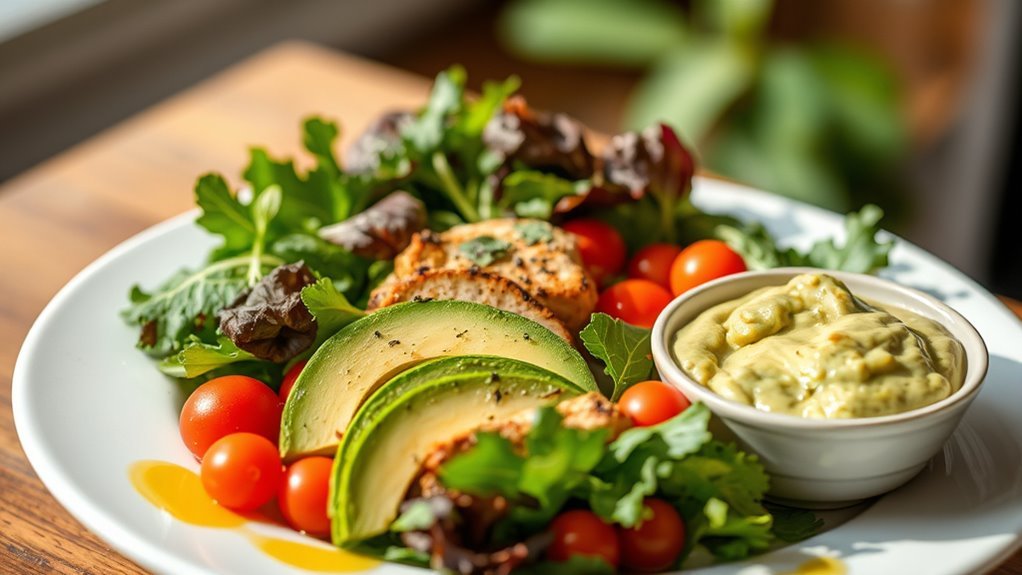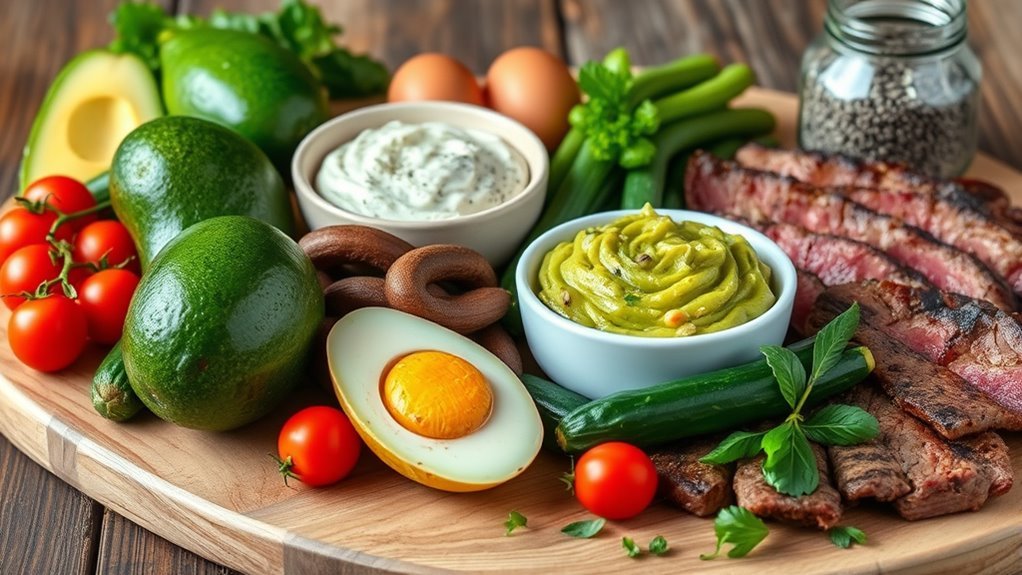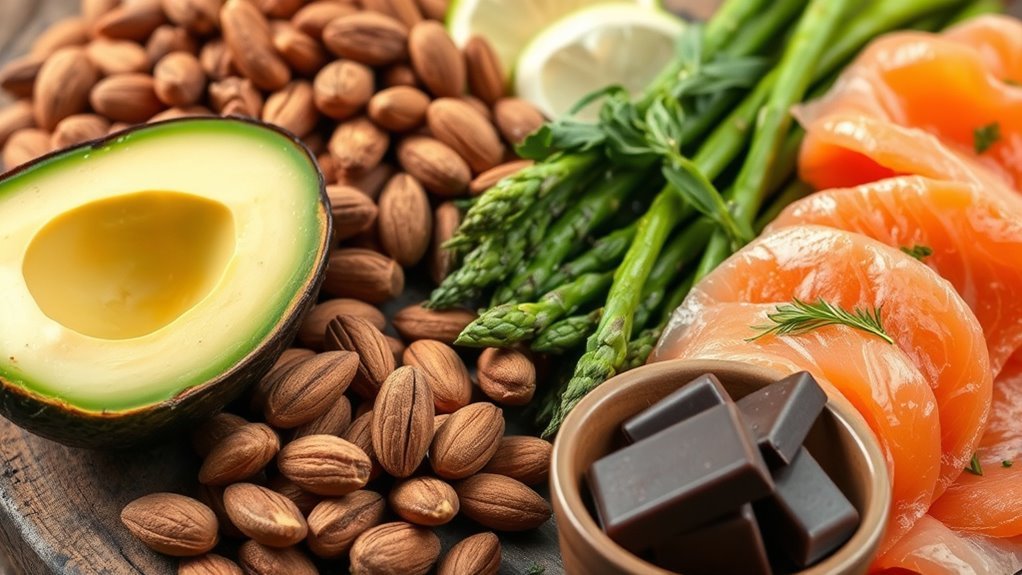On the keto diet, you’ll want to focus on high-quality proteins like chicken, salmon, and eggs. Incorporate healthy fats from sources like avocados and olive oil to fuel your body. Low-carb vegetables, such as spinach, broccoli, and bell peppers, are also key for essential nutrients. Snacks can include cheese crisps, hard-boiled eggs, or nuts. If you’re curious about optimizing your meal planning or avoiding common pitfalls, there’s so much more to explore.
Understanding the Keto Diet Basics

While many diets focus on calorie counting or restricting certain food groups, the ketogenic (keto) diet takes a different approach by emphasizing low carbohydrate intake. The fundamental idea is to shift your body’s energy source from glucose to fat through a state called ketosis. However, there are common keto diet misconceptions, such as believing it’s only for weight loss or that it’s unsustainable long-term. In reality, many people find the keto diet sustainable with proper planning and nutrient balance. It encourages the intake of healthy fats and proteins, promoting satiety and reducing cravings. Understanding these basics empowers you to make informed choices, ensuring you enjoy the freedom to maintain a lifestyle that supports your health goals.
Foods to Embrace on the Keto Diet

To successfully follow the keto diet, it is crucial to embrace a variety of foods that align with its low-carb, high-fat principles. You’ll want to stock your pantry with keto-friendly snacks and incorporate suitable meal prep options to stay on track.
Here’s a quick reference table to guide you:
| Food Category | Examples |
|---|---|
| Proteins | Chicken, Salmon, Eggs |
| Low-Carb Veggies | Spinach, Broccoli, Zucchini |
| Healthy Fats | Avocado, Olive Oil, Nuts |
Healthy Fats: The Cornerstone of Keto

Healthy fats play a pivotal role in the keto diet, serving as the primary source of energy when carbohydrate intake is minimized. You’ll want to focus on healthy fat sources like avocados, nuts, seeds, and olive oil, which provide essential nutrients and support overall health. Various cooking methods, such as sautéing or roasting, can enhance flavors while keeping fat benefits intact. Balancing your fat intake is essential; aim for approximately 70-75% of your daily calories from fats. This approach helps maintain ketosis, promotes satiety, and fuels your body efficiently. Embracing healthy fats not only adds flavor to your meals but also empowers you to enjoy freedom in your food choices while achieving your health goals on the keto diet.
Low-Carb Vegetables to Include
When you’re following a keto diet, incorporating low-carb vegetables can enhance your meals while keeping your carb intake in check. These vegetables not only provide essential nutrients but also offer various cooking options to keep your diet exciting. Let’s explore the best choices available, their nutritional benefits, and some creative ways to prepare them.
Best Options Available
While you commence on your keto journey, incorporating low-carb vegetables can greatly enhance your meals without derailing your carb count. Some of the best options include leafy greens like spinach and kale, cruciferous vegetables such as broccoli and cauliflower, and colorful bell peppers. These veggies not only offer flavor but also versatility in your keto meal prep. They can be easily added to salads, stir-fries, or roasted as side dishes. When exploring keto dining options, remember to choose vegetables that are low in carbs yet high in fiber to keep you feeling satisfied. Embracing these choices will empower you to enjoy nutritious meals while staying committed to your keto lifestyle.
Nutritional Benefits Explained
Incorporating low-carb vegetables into your keto diet not only supports your weight loss goals but also provides essential nutrients that benefit overall health. These veggies, such as spinach, broccoli, and zucchini, are rich in vitamins, minerals, and antioxidants while keeping your carb intake low. This helps you maintain ketosis, maximizing the keto diet benefits. Additionally, low-carb vegetables are high in fiber, promoting digestive health and enhancing satiety, which can prevent overeating. The nutritional advantages of these vegetables extend to reducing inflammation and supporting heart health, making them a crucial part of your daily meals. By choosing nutrient-dense, low-carb options, you’ll empower your body and enjoy the freedom that comes with a healthy lifestyle.
Creative Cooking Ideas
Low-carb vegetables not only enhance your ketogenic experience with their nutritional benefits but also offer a variety of creative cooking possibilities. You can experiment with these versatile veggies to create delicious meals and even keto friendly desserts. Here are some ideas to inspire your culinary journey:
- Zoodles: Spiralized zucchini makes a great pasta substitute, ready to be topped with your favorite sauces or creative condiments.
- Cauliflower Rice: Grate cauliflower to mimic rice, perfect for stir-fries or as a base for hearty dishes.
- Stuffed Bell Peppers: Fill colorful peppers with cheese, meats, or low-carb grains for a satisfying, wholesome meal.
Incorporating these low-carb vegetables can elevate your dishes and keep your keto diet exciting!
Protein Sources Suitable for Keto
When following a keto diet, choosing the right protein sources is essential for maintaining ketosis. Opt for high-quality meats, along with dairy and eggs, which can provide not only protein but also healthy fats. These options can help you meet your nutritional needs while keeping your carbohydrate intake low.
Best Meat Options
Choosing the right meats can considerably enhance your keto diet, as they provide essential protein while keeping carb intake low. Here are some of the best keto meat types you can include for peak nutrition:
- Fatty Cuts of Beef: Ribeye and brisket are delicious and rich in healthy fats.
- Pork: Bacon and pork belly are not only tasty but also great protein sources.
- Poultry: Chicken thighs and duck are higher in fat compared to chicken breasts, making them a better choice for keto.
Incorporating these meats into your meals will help you meet your protein needs while maintaining your carb limits. Remember, the key is to choose high-quality, grass-fed or pasture-raised options whenever possible for the best health benefits.
Dairy and Eggs
Dairy and eggs are excellent sources of protein that can seamlessly fit into your keto diet, offering both versatility and rich nutritional benefits. You can enjoy various dairy types like full-fat cheese, heavy cream, and Greek yogurt, which not only add flavor but also provide essential fats and calcium. Exploring egg varieties, such as free-range and organic options, can enhance your meals. When it comes to cheese options, think mozzarella, cheddar, or goat cheese for delicious snacks or toppings. The yogurt benefits include probiotics for gut health, making it a great addition to smoothies. Whether you’re frying, scrambling, or baking, these cooking methods keep your meals exciting. Incorporate these protein-rich foods into your meal ideas and snack options for ideal nutrition.
Dairy Products That Fit the Keto Lifestyle
What dairy products can you enjoy while following a keto lifestyle? You’ll be pleased to know there are plenty of options that fit your dietary needs. Here are some delicious choices:
- Cheese varieties: Opt for high-fat, low-carb options like cheddar, mozzarella, and cream cheese.
- Yogurt options: Choose full-fat, unsweetened Greek yogurt or coconut yogurt as a dairy alternative.
- Butter choices: Use grass-fed butter or ghee for cooking and flavoring dishes.
For added flavor and nutrients, consider incorporating cream types like heavy cream into your recipes, or sprinkle nutritional yeast for a cheesy taste without the carbs. With these selections, you can enjoy the richness of dairy while staying true to your keto goals!
Snacks to Satisfy Your Cravings
While you’re maneuvering through the keto diet, finding satisfying snacks can be a challenge, but there are plenty of delicious options that align with your low-carb goals. Keto friendly snacks can include crunchy celery sticks paired with almond butter or cheese crisps for a savory bite. You might also enjoy sliced cucumbers with guacamole, or a handful of mixed nuts, which not only curb hunger but also satisfy cravings. Hard-boiled eggs are another great choice, providing protein without the carbs. Don’t forget about low-carb veggie sticks with ranch dressing for that perfect crunch. By choosing these satisfying snacks, you can stay committed to your keto journey while enjoying tasty, guilt-free treats that keep your energy up and cravings at bay.
Sweeteners Approved for Keto
When following a keto diet, choosing the right sweeteners is essential for maintaining low-carb intake. You’ll find both natural and artificial options, each with their own benefits and drawbacks. Understanding sweetener conversion guidelines can help you substitute effectively in your favorite recipes.
Best Low-Carb Sweeteners
If you’re following a keto diet, finding the right sweeteners can be essential for maintaining your low-carb lifestyle. Luckily, there are several sugar alternatives that fit perfectly into your meal plan, especially for those delicious keto desserts. Here are some top choices:
- Stevia: A natural sweetener with zero calories and carbs, perfect for baking substitutes.
- Erythritol: A sugar alcohol that doesn’t spike blood sugar levels, making it a favorite among sweetener brands.
- Monk Fruit: A natural sweetener that’s both low-carb and calorie-free, ideal for various recipes.
These options allow you to enjoy the sweetness you crave without jeopardizing your keto goals. Explore these low-carb sweeteners and find your favorites!
Natural vs. Artificial Options
Choosing the right sweetener can make a significant difference in your keto journey, especially when considering the options available. Natural flavorings, like stevia and monk fruit, are often favored for their minimal impact on blood sugar levels and potential health benefits. They offer a more wholesome alternative, aligning with the principles of the keto lifestyle. On the other hand, artificial sweeteners, such as aspartame and sucralose, can be convenient and low-calorie, but their long-term effects on health are still debated. While they may not spike your insulin, some people experience digestive issues or cravings. Ultimately, it’s about finding what fits your body and preferences while staying true to your keto goals. Make informed choices and enjoy the sweet side of keto!
Sweetener Conversion Guidelines
Understanding sweetener conversion guidelines is essential for maintaining a successful keto diet, as not all sweeteners are created equal. Different sweetener types can affect your carb count and overall health. Here are some popular keto-friendly sweeteners along with their conversion ratios:
- Stevia: Use about 1 teaspoon of liquid stevia for every 1 cup of sugar.
- Erythritol: Substitute 1 cup of sugar with 1 cup of erythritol, as it measures equally.
- Monk Fruit: Typically, 1 cup of sugar can be replaced by 1/2 cup of monk fruit sweetener.
Meal Planning Tips for Success
Although meal planning may seem intimidating at first, it’s an essential step for success on the keto diet. Start by dedicating time each week for meal prep. This helps streamline your cooking process and guarantees you have keto-friendly meals ready to go. Focus on portion control by using containers or measuring tools to keep your servings in check. It’s easy to overindulge, even on a low-carb diet, so make certain to stick to your planned portions. Incorporate a variety of proteins, healthy fats, and low-carb vegetables to keep your meals interesting. Finally, don’t hesitate to experiment with new recipes; this keeps your meal prep exciting and enjoyable, maintaining your motivation while embracing your keto journey.
Common Mistakes to Avoid on Keto
Meal planning is an essential part of succeeding on the keto diet, but avoiding common pitfalls is equally important. Many people fall for common misconceptions that can derail their progress. Here are three mistakes to watch out for:
Meal planning is crucial for keto success, but watch out for common misconceptions that can hinder your progress.
- Not tracking macros: Ignoring your macronutrient ratios can lead to unintentional carb overload.
- Underestimating hidden sugars: Many “keto-friendly” foods still contain sugars that can kick you out of ketosis.
- Neglecting hydration: Insufficient water intake can lead to fatigue and cravings, making it harder to stick to your plan.


